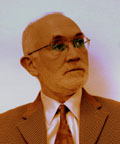Plenary Lecture
Assisted Movement of Visually
Impaired in Outdoor Environments – Work Directions and New Results

Professor Virgil Tiponut
Applied Electronic Department,
Electronic and Telecommunications Faculty,
“Politehnica” University of Timisoara,
B-dul Vasile PÔrvan 2, 300223 Timişoara,
ROMANIA
Email: virgil.tiponut@etc.upt.ro
Abstract: There are approximately 45 million blind individuals world-wide
according to the World Health Report. Vision loss limits their access to the
educational opportunities, social events, public transportation and leads to
a higher rate of unemployment than that of individuals with no functional
limitations (58% and 18% respectively, according to the American Foundation
for the Blind (AFB)). Many efforts have been invested in the last years,
based on ingenious devices and information technology, to help people to
overcome these barriers and to integrate them in the social and productive
life.
In this talk, research efforts are presented to develop electronic travel
aids (ETA) that increase the visual impaired people’s independence in their
working and living environment. These devices, based on sensor technology
and signal processing, are capable to improve the mobility of blind users (in
terms of safety and speed), in unknown or dynamically changing environment.
In particular, an integrated environment that improves the mobility of blind
persons in to a limited area is presented. The proposed solution includes
wearable equipment, placed on the subject, who guides the blind user to
navigate autonomous with obstacles avoidance and stationary, monitoring
equipment, which supervises the motion in order to avoid some unexpected
events. The 3D obstacles detection system, included in the wearable
equipment is bio-inspired, i.e. the system detects obstacles in a similar
way as a subject with normal sight is looking for obstacles in front of him.
The monitoring equipment, based on a GPS and a GSM/GPRS communication system,
is capable to track the movement of a group of visually impaired, each of
them moving on a specified pathway, in order to reach the desired target.
The man-machine interface exploits the remarkable abilities of the human
hearing system in identifying sound source positions in 3D space. The
proposed solution relies on the Acoustic Virtual Reality (AVR) concept,
which can be considered as a substitute for the lost sight of blind and
visually impaired individuals. According to the AVR concept, the presence of
obstacles in the surrounding environment and the path to the target will be
signalized to the subject by burst of sounds, whose virtual source position
suggests the position of the real obstacles and the direction of movement,
respectively.
Brief Biography of the Speaker:
Prof. Virgil TIPONUT received the M.Sc. in 1968, in Electrical Engineering/Computer
Science, and the Ph.D. degree in Electronic Engineering and
Telecommunications, in 1981, both at the POLITEHNICA University of Timisoara,
Romania. Since graduation he is with POLITEHNICA University of Timisoara and
curently he is a professor at Electronic and Telecommunication Faculty,
responsable for teaching in embedded systems, smart transducers and neural
networks.
His research interests include bioinspired systems, with application in
mobile and rehabilitation robotics and some closed related areas: smart
transducers, neural networks and fuzzy logic, biomedical engineering,
embedded systems. He has published more than 100 papers in national and
international Journals and Conference Proceedings, authored 10 books and 10
text books, and holds 21 patents. He conducted more than 25 research and
development projects, grants and contracts in the field of embedded systems,
robotics and smart transducers.
Prof. Tiponut has been involved in setting up national and international
conferences as a reviewer and/or member of organizing committee or board of
sections. He was a visiting professor at universities from USA, Germany,
Ireland and Schotland.
He is a member of the IEEE Society (CAS, EMB, RA), WSEAS Society, member of
the Society of Electronic Engineers from Romania and corresponding member of
the Academy of Technical Science from Romania.